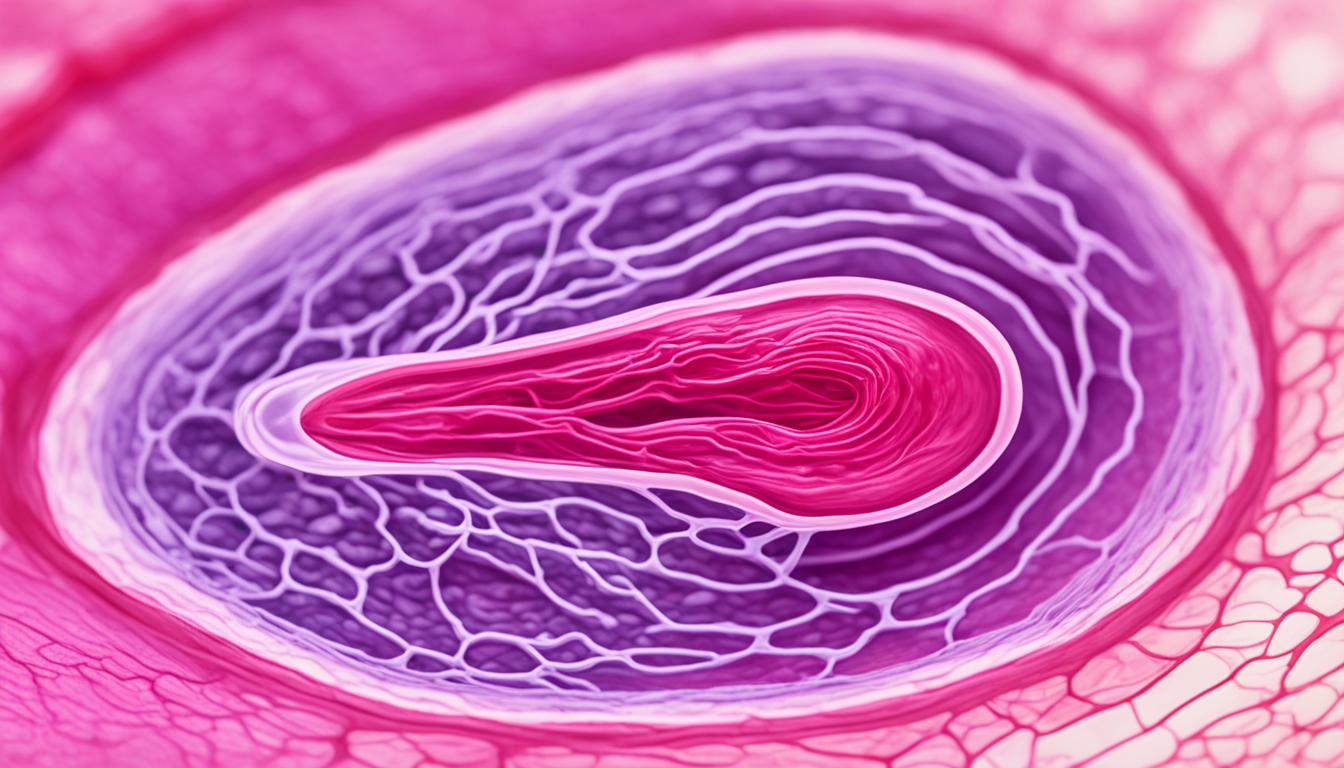A spermatocele is a benign growth found near the testicle. It is filled with fluid and might not show any signs. But if it gets big or causes pain, treatment is possible. Common signs include a lump in the scrotum or around the testicle.
The root cause of spermatocele is uncertain. Most think it happens due to blockages or harm in the tubes around the testicle. Doctors often use a physical check and ultrasound to diagnose it. Available treatments are removing it surgically or taking out the fluid. Stem cell therapy is an advancing area that might offer new treatment paths for spermatocele.
Key Takeaways:
- Spermatocele is a benign growth that develops above or behind the testicle.
- Main symptoms of spermatocele disease include a presence of a scrotal mass or testicular lump.
- Diagnosis is usually done through physical examination and ultrasound imaging.
- Treatment options include surgical removal or aspiration of the fluid.
- Stem cell therapy has shown promise in the treatment of spermatocele.
Symptoms and Causes of Spermatocele
Spermatocele often shows up as a lump on the scrotum or testicle. It’s key to know that some spermatoceles have no symptoms. They are found by chance during a check-up. This means some people with spermatocele feel fine and do not notice anything wrong.
The cause of a spermatocele is not fully clear. However, we know it’s tied to a block or damage in the tubes that carry sperm. These tubes move sperm from the testicles toward ejaculation. If these tubes are harmed, sperm collects and a cyst grows, leading to a spermatocele. So, damage to these tubes stops sperm flow correctly and can cause a spermatocele to form.
Spermatoceles are more likely if you’ve had testicle injury, infections, or surgeries. They are also common in men between 20 and 40. But, not everyone with these risks will get a spermatocele. These factors just raise the chances a bit.
Let’s review the symptoms and causes of spermatocele using this table:
| Symptoms of Spermatocele | Causes of Spermatocele |
|---|---|
| Presence of a scrotal mass | Blockage or damage to the epididymal ducts |
| Testicular lump | |
Risk factors:
|
The key symptoms of spermatocele are masses in the scrotum and testicle. Damage or blockage in the sperm tubes is a main cause. Knowing these signs and reasons is crucial for finding and treating spermatoceles. Next, we’ll look at how doctors diagnose and treat this issue.
Diagnosis and Treatment of Spermatocele
Finding out if someone has a spermatocele is key to choosing the right treatment. Doctors use a mix of looking and scanning to make sure it’s a spermatocele and not something else.
Your healthcare provider will check your scrotum by touch. They’re looking for any lumps or cysts. This check helps know more about the cyst’s size and where it is. It’s important for planning the next steps.
But sometimes, just feeling the lump isn’t enough to know for sure. That’s when they turn to ultrasound. This tool uses sound waves to show detailed images of what’s inside your scrotum. It can confirm if you have a spermatocele.
What happens next depends on how the cyst affects you. If it causes pain or other issues, treatment may be needed.
The main way to treat a spermatocele is to remove it surgically. The surgery is called spermatocelectomy. It’s a quick process done with you awake, and usually, you can go home the same day. Surgery often solves the problem well.
But you may not always need surgery. With smaller cysts, your doctor might suggest draining the fluid with a needle. This is called aspiration. It can help ease the pain. But remember, the cyst might come back more often with this method.
Choosing what treatment to go with depends on many things. Your general health, the cyst’s size, and your symptoms all matter. It’s best to talk to your doctor about what’s the best plan for you.
Key Takeaways
- Spermatocele diagnosis involves a physical examination and ultrasound imaging
- Ultrasound imaging helps confirm the presence of a spermatocele and provides detailed information about its size and structure
- Treatment options include surgical removal (spermatocelectomy) or aspiration of the cyst’s fluid
- Surgical removal is recommended for symptomatic or larger cysts, while aspiration may be suitable for smaller cysts or patients unsuitable for surgery
- It is important to consult with a healthcare professional to determine the most appropriate treatment option
Stem Cell Therapy for Spermatocele
Stem cell therapy is a new way to treat certain health issues, like spermatocele. It uses the amazing power of stem cells to fix damaged tissues. For those with spermatocele, this therapy can help heal the epididymal ducts and make sperm flow right again.
This new treatment is still being studied but shows great promise. It can shrink the spermatocele cysts and make the symptoms better. It’s grabbing the attention of doctors and patients because it aims at the main issue.
Still, we need more studies to be sure about the long-term effects and safety of this therapy for spermatocele. More research is key to making sure this new way of treating the condition works well and is safe. It could be a big help for those dealing with spermatocele.

